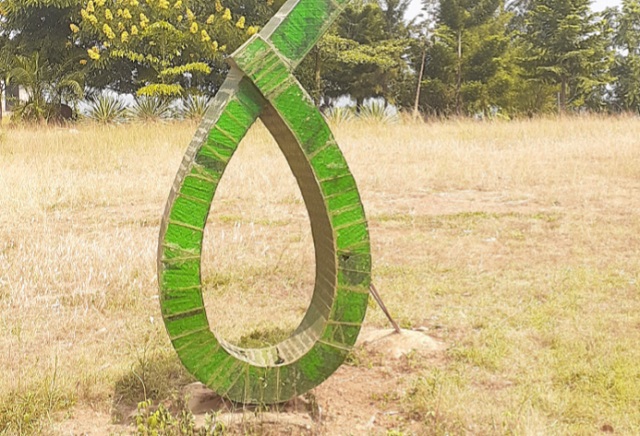
Open air sculptures in that mirror a community’s cultural heritage
The Independent | DOMINIC MUWANGUZI | The perception that art only resides in the traditional art spaces like museums and galleries is quickly overturned when one visits Weaver Bird Sculpture Park, located almost 7 km from Masaka town, on the south- eastern part of Uganda.
Sitting on top of a sprawling hill overlooking a famous swamp and nestling in a canopy of wildly growing eucalyptus trees, the space inhabits several sculptures constructed from a variety of media; including concrete, stained glass, fiber glass and plastic off-cuts. They are evenly spread out on a vast acreage of land measuring approximately fifteen acres with scrubs of glass offering a rustic ambience to the visitor. Even the two square bathrooms, sitting side by side, evoke an identity of sculptures. They were built with a mixture of concrete and rock extracted from the foothill of the hill by the community in the tradition of collaborative art making. It’s a process that can be traced back to African traditional communities; where the artisan worked directly with the community to produce art.
The sculptures here were all built with the participation of the community and a number of artists visiting the space. In this, they mirror the culture and traditional heritage of the space within which they are situated. For example, the vast garbage can by Ronex, is used to collect garbage at the camp. This trash bin encourages and promotes the idea of keeping the environment clean to ensure healthy lives of the communities. This practice of community environment responsibility is a rejoinder to the tradition of Bulungi Bwansi that is still practiced in Buganda under the auspices of the Kabaka chiefs found in every district of the Kingdom.
A few minutes from the bin constructed from aluminum off-cuts, is the board game (Omweso) installation. The board game- supposedly introduced by the Bachwezi of Bunyoro-kitara Kingdom to Buganda- was a popular game in the kingdom played for leisure by fully grown up men only.
The presence of these symbolic installations- central to the Buganda culture- suggests the intentional approach to art production by the artists which is to interact with the community.
Community interaction with the art does not stop at the local community visiting the park, but is spread out to the vast audiences including young corporates from Masaka town centre, school children from international schools like Kampala International School Uganda (KISU), GEM International Schools and the tourist community who want to interact with indigenous artworks. This is obviously a departure to the norm of public art display in spaces restricted to most of the public. This limitation to access art in the public distances the community from the art and it can be argued from this point that the art in the open spaces does not speak to the people. It is possibly erected to communicate a political narrative or for tourists.
The Weaver Bird Sculpture Park challenges such a divide between art and public. The sculptures and installations at the site are clearly accessible to the public through open access to the park to both the local and tourist community and the construction process of the artworks on display.
An interactive art project like this may never have been successful if it was not for the ethical inculcation of unity at the centre. To illustrate this theme of unity, at the centre of the small village is a towering monument measuring above 20ft tall. It is the Monument of Unity 2012 depicting three abstract figures: Father, Mother and Child evoked as a symbol of unity in the family. According to Joe Bukenya, community artist and my guide for this tour, the concrete sculpture was built by a group of artists from Kenya under the Kuona Arts Trust collective and a section of Ugandan artists to demonstrate to the community the significance of unity in the community. “Everything in this community is done together. For example, all the art projects in this community are worked on by the community and this bonds us together,” says Bukenya.
The manner in which this sculpture park is related to the community is an essential inspiration to art in public spaces, not only in Kampala but across the region. As a form of creating new ways of interacting with art, the sculptures here mirror the cultural heritage of the community and provide a platform to freely express oneself. This is witnessed in the wall mural that bears diverse scribbling of different people reacting to varied issues in their community.
****
Weaver Bird Sculpture Park is part of Weaver Bird Community of the Arts located in Ndegeya village in Masaka. It is a brainchild of Collin Sekajugo, a community artist who established it in 2012 to give back to the community.
 The Independent Uganda: You get the Truth we Pay the Price
The Independent Uganda: You get the Truth we Pay the Price


